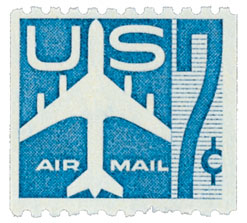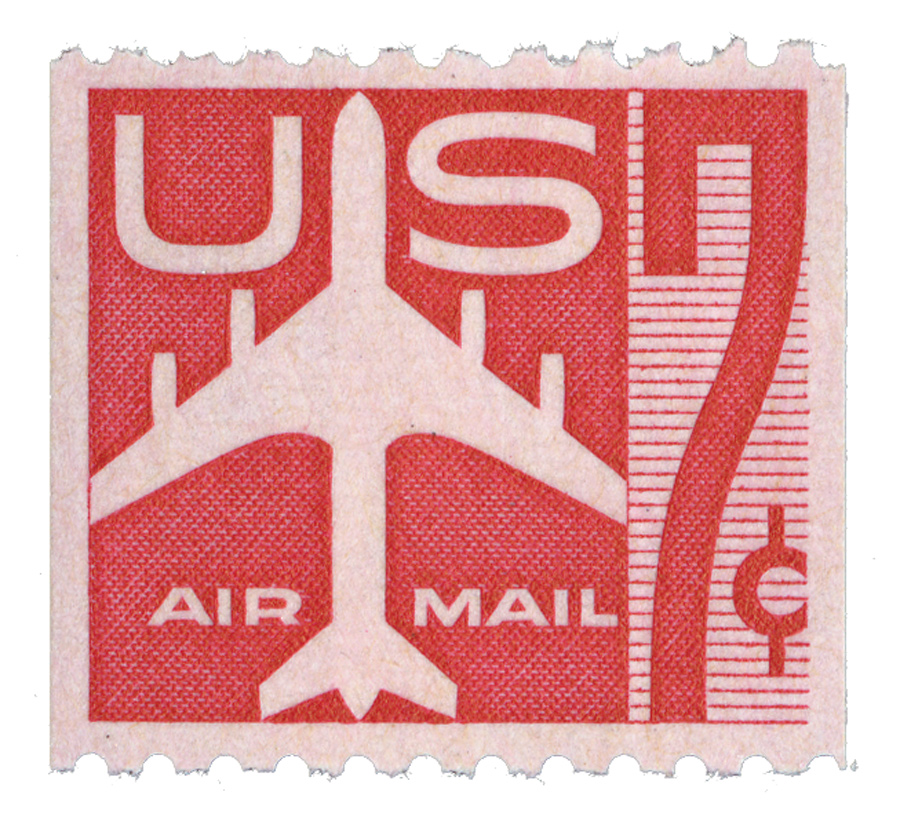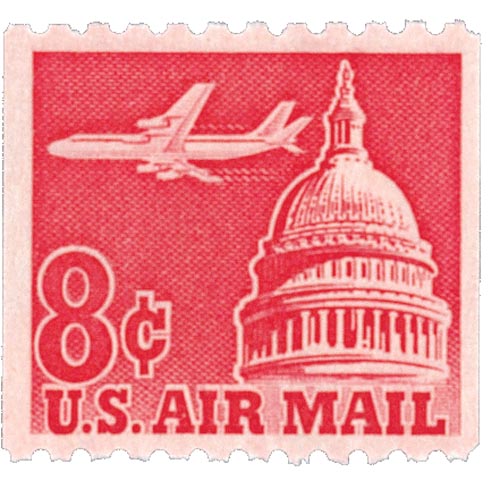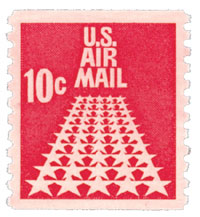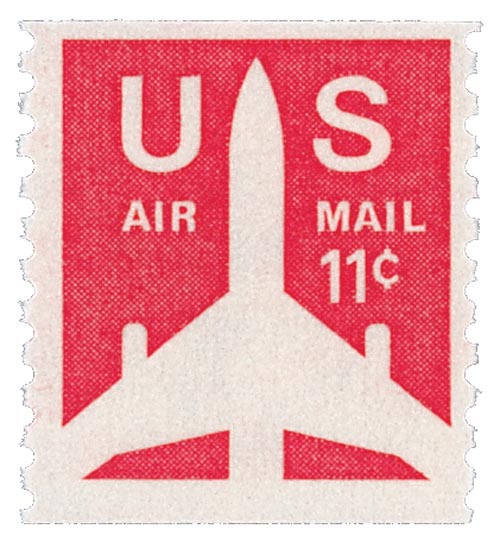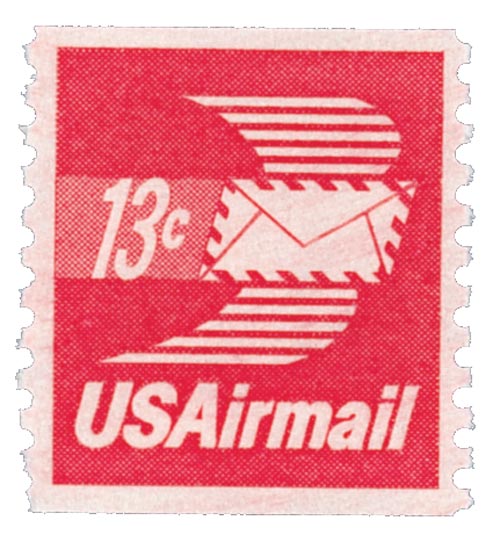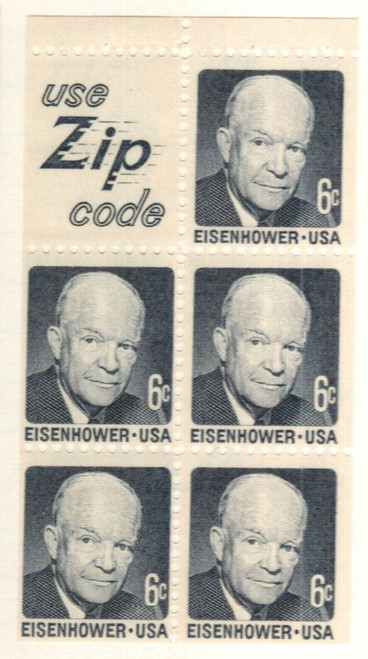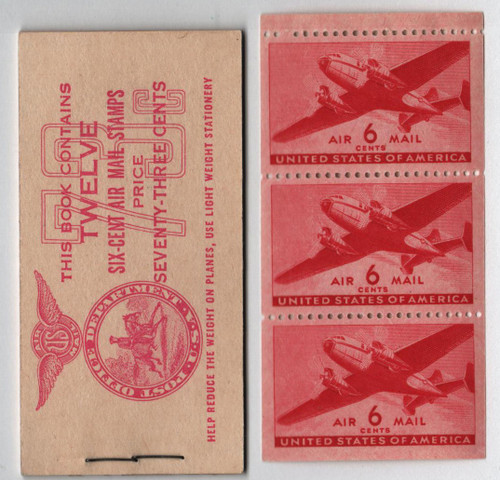
# C39a - 1949 6c DC-4,bklt pane of 6
Â
1949 6¢ DC-4 Skymaster
Color: Carmine
The first US Airmail coil stamp was issued on January 15, 1948, in Washington, DC. Only a few more coil stamps would be issued over the next 30 years, but the DC-4 SkyMaster would appear on more than a dozen postal items. The DC-4 SkyMaster made its maiden flight on February 14, 1942. The aircraft quickly played a critical role in the Allied war effort and the Berlin Airlift of 1948-49. The SkyMaster was also widely used in commercial aviation and to deliver airmail. The first SkyMaster stamp was issued in 1946 to pay the reduced rate of domestic airmail from 8¢ per ounce to 5¢ per ounce. This included airmail sent to and from US territories including Hawaii, Guam, and the Canal Zone. This was a savings of up to 90¢ per ounce. The stamp and a matching Airmail Stationery Envelope were issued on September 25, but the rate didn’t take effect until October 1. The SkyMaster issue was soon known as the “Nickel Air Mail Stamp†and was promoted during National Air Mail Week. The Post Office also reported an increase of 19 million airmail letters sent in the first two weeks of October compared to the first two weeks of September, which they credited to the new lower rate. On March 26, 1947, the SkyMaster design appeared on a new, smaller airmail stamp. The smaller size was adopted in preparation for future issues that could be used as coils or booklets and sold in vending machines. A month later, the Post Office issued its first Air Letter Sheet, which also picture the SkyMaster. And in May, they issued a Postal Stationery Envelope to celebrate the 100th anniversary of US postage stamps. The embossed stamp had the busts of Washington and Franklin (who appeared on the first two US stamps) plus different methods of mail delivery, including a shop, a horse rider, and a DC-4 SkyMaster. Then on January 15, 1948, the Post Office issued its very first airmail coil stamp. The new stamp was only available in coils of 500, which cost $25. That was a large sum for the time, plus the stamps weren’t properly formatted for current vending machines. So most individuals didn’t use them, instead they were usually used by corporations and other groups. The 5¢ SkyMaster coil stamp was also issued in much lower numbers than the other SkyMaster stamps. While the previous SkyMaster stamps were issued in the hundreds of millions, only about 33 million coils were printed. In all, only about 2% of all the SkyMaster stamps issued were coils. The 5¢ Airmail rate was in effect until December 31, 1948, after which it rose to 6¢. A new 6¢ SkyMaster stamp was issued in sheet form on January 18, 1949. And on August 25, 1949, a new 6¢ SkyMaster coil stamp was issued. As with the previous coil stamp, it was only available in rolls of 500, so most of the stamps were used by businesses. There was also a 6¢ SkyMaster booklet stamp issued on November 18, 1949. It was one of the last two booklets to be issued at a price of 1¢ above the face value. After this, the DC-4 SkyMaster was used on a few more Stationery Envelopes and Air Letters. In all, the SkyMaster appeared on more than a dozen different postal items between 1946 and 1958. There were only a handful of other Airmail coils issued in the years to come, with the last being issued in 1976:First Airmail Coil Stamp
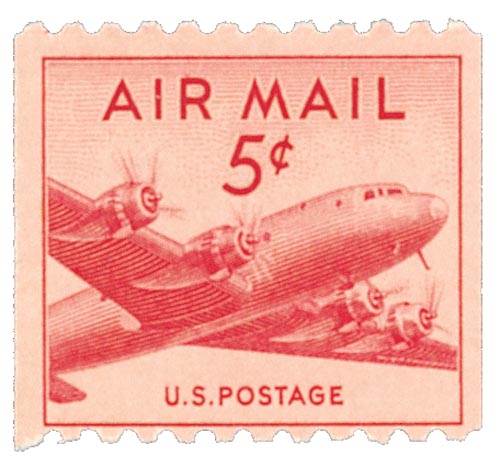
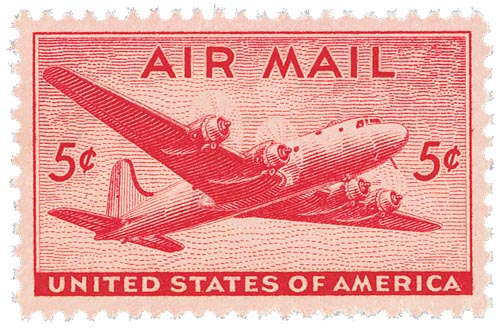
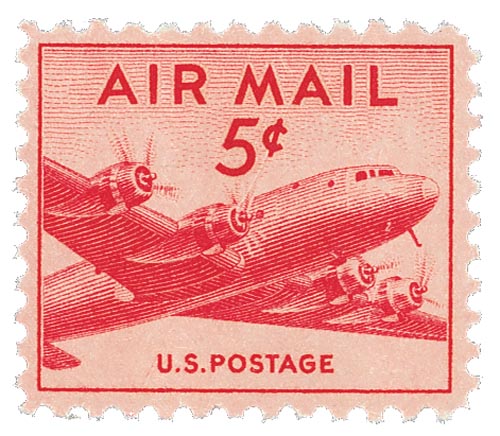

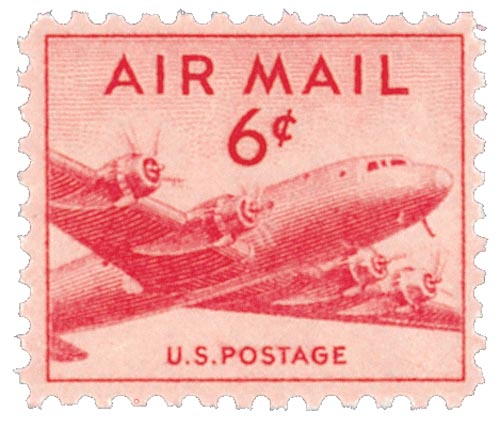
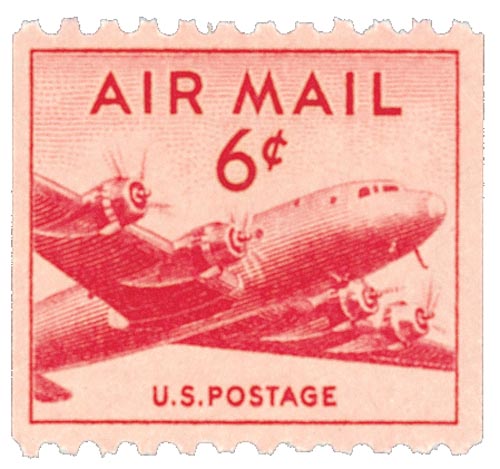
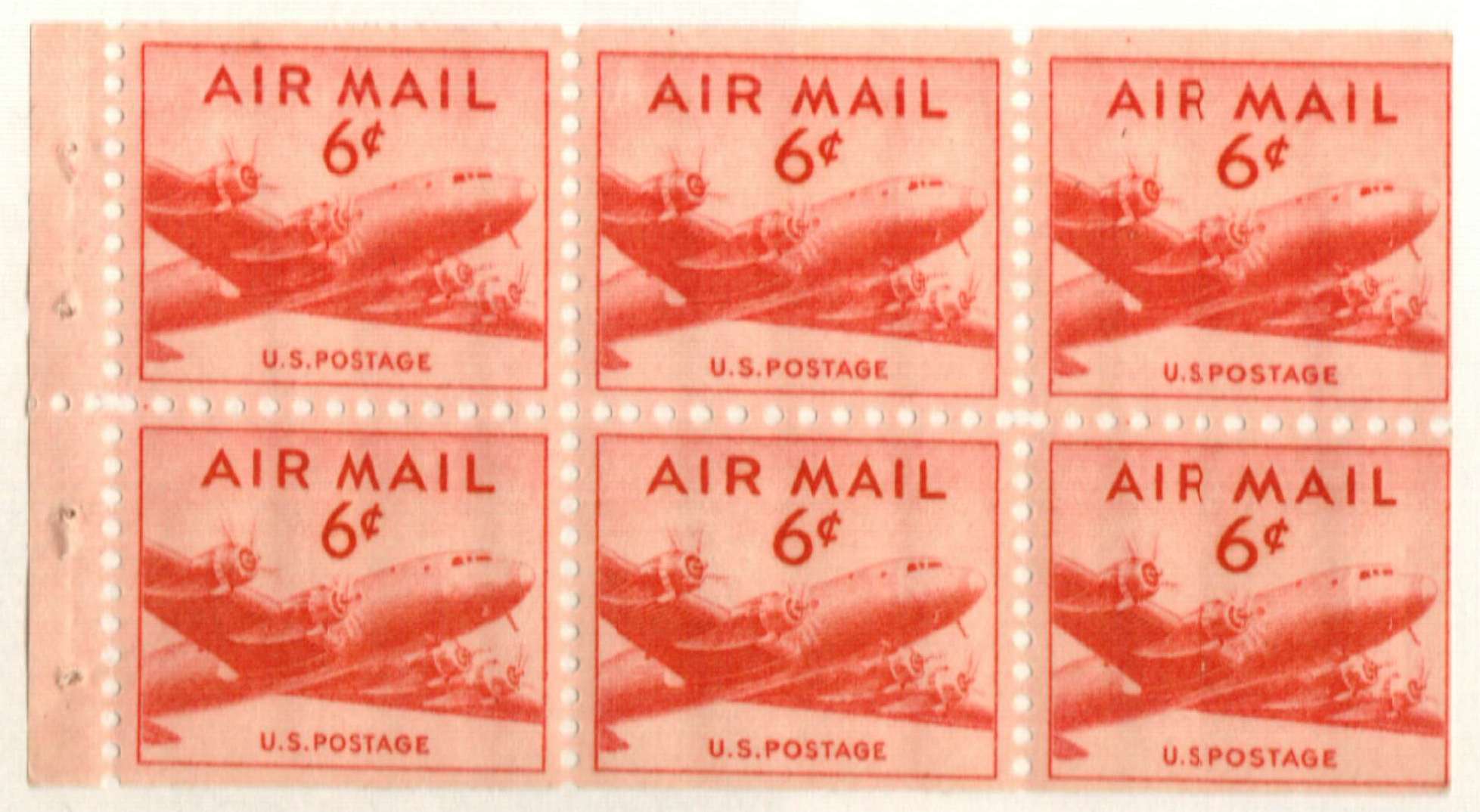



Â
Â
1949 6¢ DC-4 Skymaster
Color: Carmine
The first US Airmail coil stamp was issued on January 15, 1948, in Washington, DC. Only a few more coil stamps would be issued over the next 30 years, but the DC-4 SkyMaster would appear on more than a dozen postal items. The DC-4 SkyMaster made its maiden flight on February 14, 1942. The aircraft quickly played a critical role in the Allied war effort and the Berlin Airlift of 1948-49. The SkyMaster was also widely used in commercial aviation and to deliver airmail. The first SkyMaster stamp was issued in 1946 to pay the reduced rate of domestic airmail from 8¢ per ounce to 5¢ per ounce. This included airmail sent to and from US territories including Hawaii, Guam, and the Canal Zone. This was a savings of up to 90¢ per ounce. The stamp and a matching Airmail Stationery Envelope were issued on September 25, but the rate didn’t take effect until October 1. The SkyMaster issue was soon known as the “Nickel Air Mail Stamp†and was promoted during National Air Mail Week. The Post Office also reported an increase of 19 million airmail letters sent in the first two weeks of October compared to the first two weeks of September, which they credited to the new lower rate. On March 26, 1947, the SkyMaster design appeared on a new, smaller airmail stamp. The smaller size was adopted in preparation for future issues that could be used as coils or booklets and sold in vending machines. A month later, the Post Office issued its first Air Letter Sheet, which also picture the SkyMaster. And in May, they issued a Postal Stationery Envelope to celebrate the 100th anniversary of US postage stamps. The embossed stamp had the busts of Washington and Franklin (who appeared on the first two US stamps) plus different methods of mail delivery, including a shop, a horse rider, and a DC-4 SkyMaster. Then on January 15, 1948, the Post Office issued its very first airmail coil stamp. The new stamp was only available in coils of 500, which cost $25. That was a large sum for the time, plus the stamps weren’t properly formatted for current vending machines. So most individuals didn’t use them, instead they were usually used by corporations and other groups. The 5¢ SkyMaster coil stamp was also issued in much lower numbers than the other SkyMaster stamps. While the previous SkyMaster stamps were issued in the hundreds of millions, only about 33 million coils were printed. In all, only about 2% of all the SkyMaster stamps issued were coils. The 5¢ Airmail rate was in effect until December 31, 1948, after which it rose to 6¢. A new 6¢ SkyMaster stamp was issued in sheet form on January 18, 1949. And on August 25, 1949, a new 6¢ SkyMaster coil stamp was issued. As with the previous coil stamp, it was only available in rolls of 500, so most of the stamps were used by businesses. There was also a 6¢ SkyMaster booklet stamp issued on November 18, 1949. It was one of the last two booklets to be issued at a price of 1¢ above the face value. After this, the DC-4 SkyMaster was used on a few more Stationery Envelopes and Air Letters. In all, the SkyMaster appeared on more than a dozen different postal items between 1946 and 1958. There were only a handful of other Airmail coils issued in the years to come, with the last being issued in 1976:First Airmail Coil Stamp










Â






